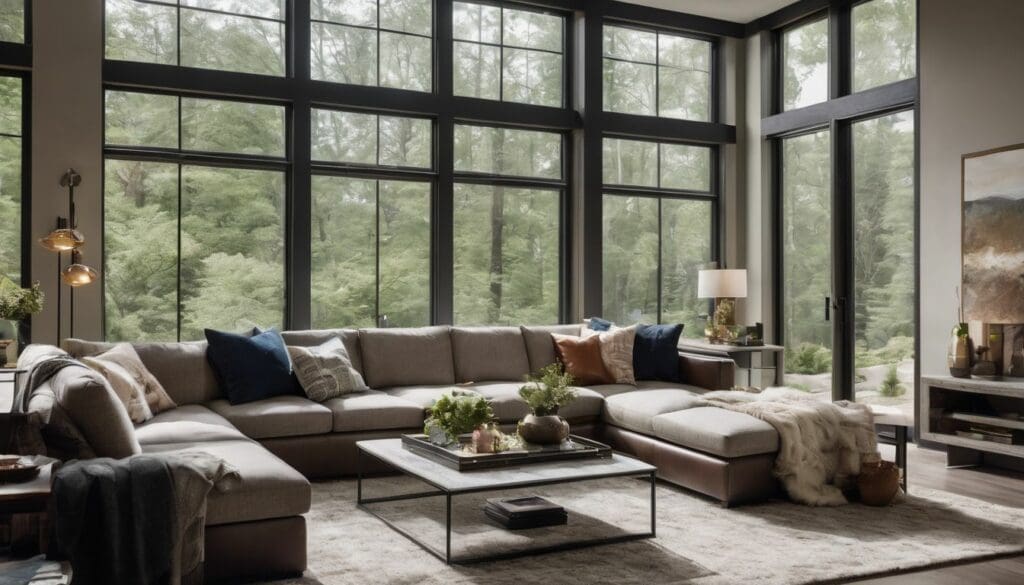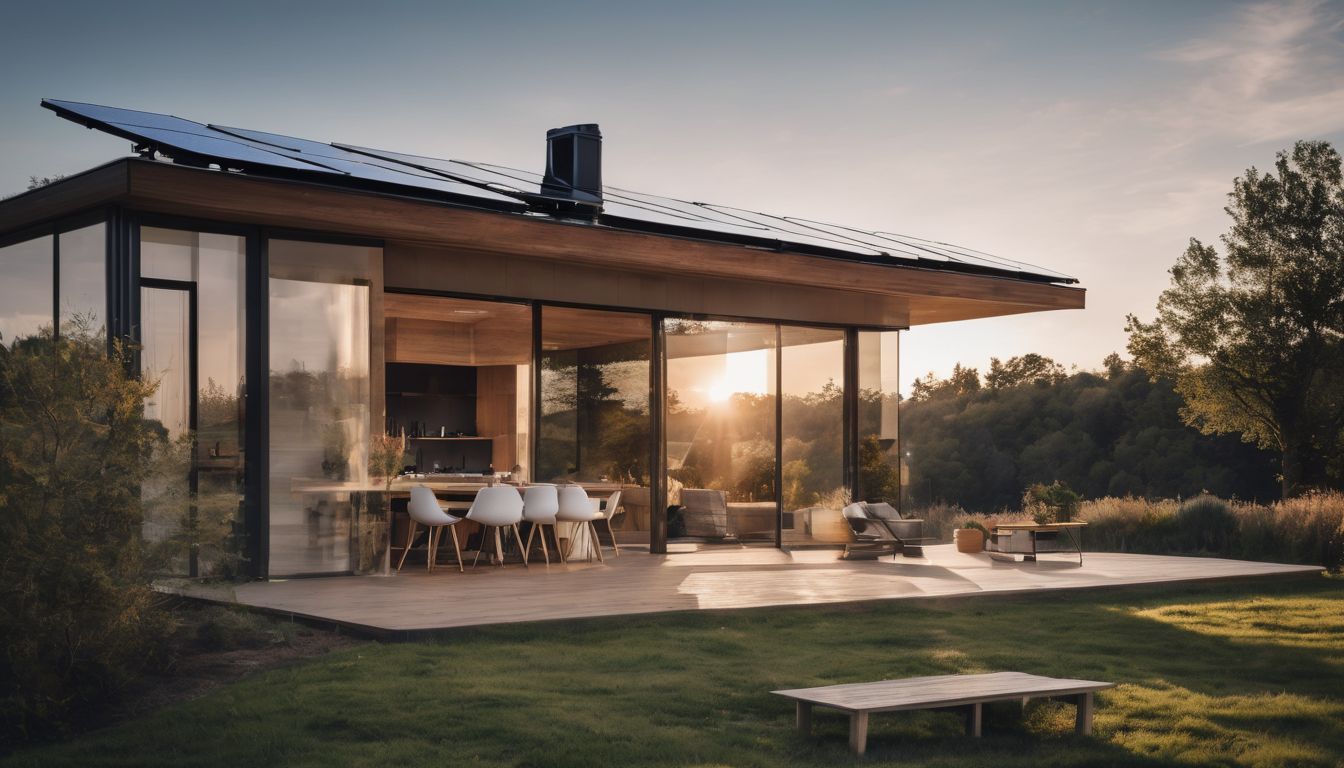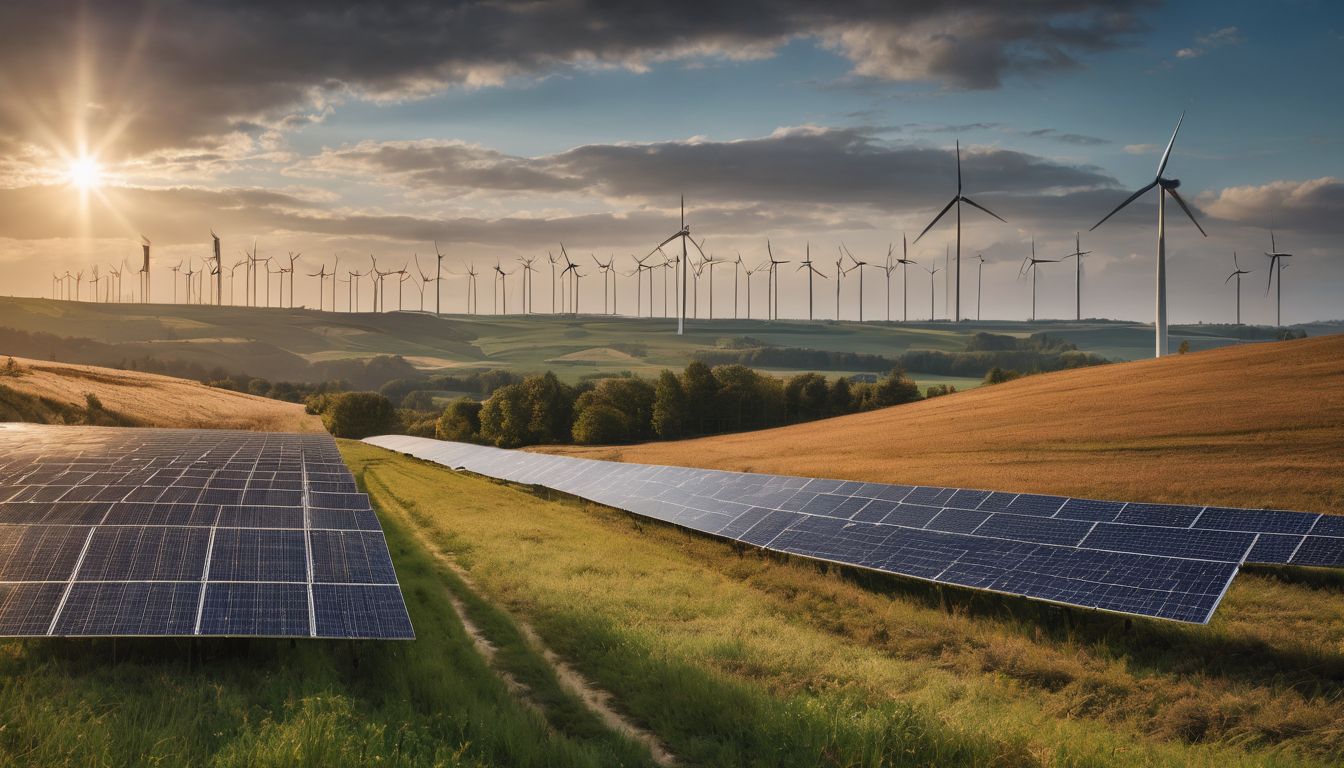As winter chills creep in or summer heat blazes, your home’s comfort might be slipping through the windows. Windows can lose more heat per square metre in winter and gain more heat in summer than any other surface in your home.
This article outlines smart, energy-efficient solutions to enhance your window’s ability to keep you cosy or cool, all year round. Discover easy fixes that save money and the planet!
Key Takeaways
- Cellular shades, also called honeycomb shades, are top energy-efficient window coverings that help maintain comfortable indoor temperatures by creating insulating air pockets.
- Different types of window treatments such as drapes with thermal linings, roller shades and solar films can be combined to maximise home insulation and control over heat gain and natural light entry.
- Smart technology integration allows for automated adjustment of window treatments based on time of day or temperature changes, enhancing energy savings in the home.
- Regular maintenance and cleaning of window coverings is essential for their effectiveness in reducing energy consumption by preventing heat loss or gain through windows.
- Installing awnings provides added shade to reduce solar heat entering your home while contributing to its exterior aesthetics and promoting sustainability through reduced reliance on heating and cooling systems.
How Window Treatments Impact Energy Efficiency
Window treatments play a crucial role in regulating the temperature of your home, providing insulation in winter and cooling in summer. They also control solar heat gain and utilise natural light effectively for energy efficiency.
Providing insulation in winter and cooling in summer
Effective window treatments act like a thermal blanket during the cold months. They trap heat inside to keep your home cosy without overworking the heating system. This insulation means less energy is used, and you save on heating bills.
In summer, these smart solutions reflect sunlight and heat, keeping rooms cooler naturally. By doing so, they reduce the need for air conditioning which slashes energy consumption.
Choosing the right materials and styles makes all the difference in how well your coverings perform. Insulating window treatments such as thick drapes or cellular shades create a barrier against temperature extremes.
Thermal linings can be added for extra protection against heat loss or gain. Lighter colors reflect more sunlight, which enhances cooling in warmer weather while darker colors absorb it for additional warmth when needed.
Controlling solar heat gain
Controlling solar heat gain is essential for maintaining a comfortable indoor temperature and reducing the reliance on artificial cooling systems. Utilising roller shades, shutters, blinds, or window films can effectively block out excess sunlight and heat, while still allowing natural light to brighten up your home.
By strategically managing solar heat gain through energy-saving window coverings, you can significantly lower your energy consumption and contribute to sustainable living practices.
Installing thermal window coverings like roller shades or shutters helps in regulating the amount of heat entering your home during hot weather. By actively addressing solar heat gain with these solutions, you not only create a more comfortable living environment but also play an active role in conserving energy and reducing carbon emissions.
Using natural light
Maximising natural light is a key strategy in energy-efficient window solutions. Harnessing sunlight reduces the need for artificial lighting, cutting down on electricity consumption.
It also provides warmth during colder months, reducing reliance on heating systems and contributing to lower energy bills. By strategically utilising natural light through your window treatments, you can achieve a more sustainable and eco-friendly home environment.
Efficiently managing natural light helps regulate indoor temperatures and creates a comfortable living space without compromising energy efficiency. It is essential for environmentally conscious individuals looking to reduce their carbon footprint while maintaining a well-lit and inviting home atmosphere.
The Top Energy-Efficient Window Treatments
When it comes to energy-efficient window treatments, you have plenty of options to choose from. From cellular shades and drapes with thermal linings to roller and solar shades, there are solutions that can help control heat gain and loss in your home.
Shutters, blinds, window films, and awnings are also effective choices for improving the energy efficiency of your windows.
Cellular Shades (Honeycomb Shades)
Cellular shades, also known as honeycomb shades, are an excellent choice for energy-efficient window treatments. These shades have a unique honeycomb design that creates air pockets which act as insulation, preventing heat transfer through the windows.
This helps to maintain a comfortable indoor temperature and reduces the need for excessive heating or cooling. Additionally, cellular shades effectively block out solar heat gain in the summer and trap warm air inside during winter months, making them a key component of an energy-saving home.
Moreover, cellular shades come in various opacities, allowing you to control the amount of natural light entering your space without compromising on privacy. By maximising natural light while reducing heat gain or loss, these shades contribute to overall energy efficiency in your home.
Drapes / Curtains / Thermal Linings
To complement the energy-saving benefits of cellular shades, drapes, curtains, and thermal linings offer an extra layer of insulation for your windows. By effectively blocking out draughts and preventing heat loss during winter, these window treatments help maintain a comfortable indoor temperature while reducing the need for excessive heating.
In the summer months, they also play a crucial role in keeping your home cool by preventing solar heat gain. Choosing thermal linings made from insulating materials such as wool or polyester further enhances their energy-efficient properties.
By installing drapes or curtains with thick fabric and adding thermal linings to them, you can significantly reduce heat transfer through your windows. This not only minimises your reliance on heating and cooling systems but also contributes to overall energy efficiency in your home.
Roller / Solar / Roman Shades
Roman Shades are a stylish and energy-efficient window treatment option. They provide excellent insulation, reducing heat loss in winter and keeping cool air inside during the summer months.
These shades also help to control solar heat gain, preventing excessive heat from entering your home. By allowing natural light to filter through while maintaining privacy, Roman Shades contribute to energy savings by minimising the need for artificial lighting during the day.
Solar shades are a smart choice for environmentally conscious individuals seeking energy-efficient window solutions. Their design effectively blocks UV rays and reduces glare while still preserving outward visibility.
Shutters / Blinds
Shutters and blinds are excellent energy-efficient window treatments. They effectively block out heat during hot summer months, reducing the need for excessive air conditioning. By providing insulation in winter and preventing heat gain in summer, these coverings contribute to maintaining a comfortable indoor temperature.
Moreover, shutters and blinds allow users to control natural light entry, further enhancing energy efficiency by minimising the need for artificial lighting. Additionally, their adjustable slats offer homeowners flexibility in managing solar heat gain according to their specific needs.
When selecting window treatments for energy efficiency, consider shutters and blinds as effective options that not only help conserve energy but also add a stylish touch to your home decor.
Window Films
Window films are a cost-effective way to enhance energy efficiency in your home. They block heat and UV rays, reducing the need for excessive air conditioning during hot summers. Additionally, they provide insulation during winter months, helping you save on heating costs as well.
These films also help protect your furniture and flooring from sun damage, making them an eco-friendly choice for environmentally conscious individuals. By installing window films, you can enjoy a comfortable indoor environment while contributing to energy conservation efforts.
Maximising Energy Efficiency through Awnings
Awnings
When considering energy-efficient window solutions, awnings are a viable option for reducing heat gain and improving insulation in your home. Awnings effectively block sunlight and reduce solar heat gain, helping to maintain a cooler indoor temperature during the warmer months.
By providing shade over windows, awnings can significantly decrease the need for air conditioning, contributing to lower energy consumption and cost savings. Additionally, awnings offer protection from rain and snow, adding an extra layer of weatherproofing to your home.
Awnings also enhance the aesthetic appeal of your property while promoting sustainability by reducing reliance on heating and cooling systems. Available in various styles and materials such as fabric or aluminium, they add character to your exterior while providing functional benefits.
Maximising Energy Efficiency with Window Coverings
Combine different types of window coverings to maximise insulation and solar heat control, ensuring that each window is equipped with the right type of treatment for optimal energy efficiency.
Read on to discover how you can make your home more energy efficient with the best window solutions.
Combining window coverings
To maximise energy efficiency, consider combining different window coverings. For example, layering cellular shades with drapes or curtains can provide extra insulation and reduce both heat gain and loss.
Likewise, pairing roller shades with blinds or shutters can offer enhanced control over natural light and temperature regulation. These combinations allow for custom solutions that cater to specific needs of each room while reducing energy consumption.
By mixing various types of window treatments strategically throughout your home, you can effectively enhance energy efficiency without compromising on style or functionality. Whether it’s combining awnings with window films or using a combination of Roman shades and thermal linings, exploring different combinations helps to achieve a comprehensive approach to energy-saving in your living space.
Choosing the right type of coverings for each window
Select window coverings based on the unique needs of each window. Consider factors such as sunlight exposure, desired level of privacy, and energy efficiency requirements. For instance, cellular shades or honeycomb shades can provide excellent insulation for windows that get direct sunlight, while roller or solar shades may be more suitable for windows in cooler areas needing additional warmth.
Blinds and shutters are great options for adjustable light control and protection from heat gain. It’s important to tailor your choice of window treatments to maximise energy savings throughout your home.
Lastly, avoid a one-size-fits-all approach when it comes to choosing the right window coverings – this will help you achieve maximum energy efficiency and comfort within different areas of your home.
The Best Energy-Saving Tips for Your Home
Choose an energy-efficient electricity or natural gas plan, utilise smart technology for window treatments, and properly maintain and clean your window coverings to maximise energy savings in your home.
For more tips on how to save energy and reduce your carbon footprint, keep reading!
Choosing an energy-efficient electricity or natural gas plan
When selecting an energy-efficient electricity or natural gas plan, compare the options provided by different suppliers. Research their green energy initiatives and check if they offer renewable energy plans.
Look for tariff structures that encourage off-peak usage to save on costs and support sustainability.
Consider signing up for a plan with smart technology features such as smart meters or home automation systems. These tools can help you monitor your energy usage more effectively and control it remotely, leading to greater efficiency and potential cost savings.
Utilising smart technology for window treatments
Maximising energy efficiency extends to utilising smart technology for window treatments. Automated blinds and shades can be programmed to adjust based on the time of day or temperature changes, helping to regulate indoor climate and reduce the need for excessive heating or cooling.
Smart sensors can also be integrated with window coverings to detect sunlight and automatically open or close them as needed, optimising natural light usage while minimising heat gain.
Furthermore, smart home systems offer the convenience of controlling window treatments remotely via smartphones or voice commands, ensuring that energy-saving adjustments can be made even when homeowners are away.
Properly maintaining and cleaning window treatments
To maintain and clean window treatments effectively, regularly vacuum or dust them to prevent dirt and dust buildup. Use a gentle fabric cleaner or detergent for washable materials, ensuring to follow the manufacturer’s cleaning instructions.
For non-washable coverings, spot-clean using a soft cloth and mild soap. Dust blinds with a microfiber cloth or use a handheld vacuum with an attachment designed for blinds. Regularly inspect for any damage or wear and tear, repairing as needed to ensure optimal energy efficiency.
Proper care of window treatments contributes significantly to their longevity and effectiveness in providing insulation, controlling solar heat gain, and enhancing energy efficiency in your home.
Conclusion
In conclusion, energy-efficient window treatments can significantly reduce your home’s energy consumption. Choosing the right window coverings and implementing energy-saving tips can help you create a comfortable and eco-friendly living space.
By maximising energy efficiency with the appropriate window solutions, you can contribute to conserving natural resources while enjoying a lower carbon footprint. Make informed decisions about your window treatments to achieve both environmental and cost savings benefits for your home.
FAQs
1. What are energy-efficient window solutions?
Energy-efficient window solutions include treatments like drapes, curtains, blinds, roller shades, and window quilts that help block heat and save energy in your home.
2. How do curtains and drapes improve energy efficiency?
Curtains and drapes for energy efficiency work by creating a barrier to keep heat out during summer and trap warmth inside during winter, reducing the need for heating or cooling.
3. Can installing blinds really help with my home’s energy saving?
Yes! Blinds for energy efficiency can reflect sunlight away from your home on hot days, keeping rooms cooler without overworking air conditioners.
4. What are roller shades, and how do they contribute to insulation?
Roller shades fit tightly to windows and act as an insulative layer against cold draughts in winter or extreme heat in summer, contributing significantly to your home’s overall insulation.
5. Are there any eco-friendly options for weatherising my windows?
Absolutely! There are various eco-friendly materials used in green building that make up weatherisation products which form part of energy efficiency programmes aimed at making homes more sustainable.





